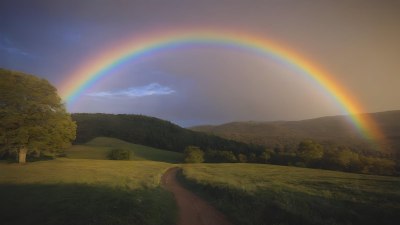Why Rainbows Are Just the Universe’s Apology for Messing with Your Day
Explore the whimsical idea that rainbows are the universe's way of apologizing for life's challenges.

Image by kucingliarz on Freepik
Rainbows have captivated humanity for centuries, not just due to their stunning beauty but also because of the myths and stories surrounding them. Whenever the sun shines after a storm, the presence of a rainbow can invoke a feeling of relief, joy, and wonder. Some people even perceive rainbows as symbolic gestures from the universe, messages of hope or signs of better days ahead. This article delves into the captivating idea that rainbows are, in fact, the universe's unique apology for messing with our day, serving not only as a meteorological phenomenon but also as a metaphor for resilience and optimism.
To understand this notion, we first need to explore what a rainbow is. Scientifically, a rainbow is a meteorological phenomenon that occurs when light is refracted, reflected, and dispersed through water droplets in the atmosphere. This interaction creates a spectrum of light, presenting itself often as a magnificent arc of colors in the sky. The most commonly recognized sequence of colors in a rainbow is red, orange, yellow, green, blue, indigo, and violet, often abbreviated as ROYGBIV. Each rainbow begins with the light source—which is typically the sun—and is visible only when there is moisture in the air, creating the perfect conditions for this optical illusion.
However, if we shift our perspective from the scientific to the symbolic, rainbows take on a whole new meaning. Many cultures have tied rainbows to various mythologies throughout history. In Norse mythology, the rainbow bridge, Bifröst, connects the realm of the gods to Earth, symbolizing a pathway to greater understanding and connection. In biblical stories, the rainbow is famously known as God’s promise to humanity after the flood, serving as an emblem of hope and renewed life. This cultural significance hints at a universal appreciation for the moment rainbows bring—an uplifting sight after a troubling storm.
When faced with difficulties or adversities, how often do we long for something fleetingly beautiful to signify a return to tranquility? Rainbows strikingly fulfill that role. They serve as visual reminders that beauty can emerge from chaos, encapsulating the notion that our struggles might lead to moments of unexpected joy. Indeed, they seem to arrive right when we need them the most, making many perceive them as apologies from the universe for the storms we endure. It’s as if the universe, in its infinite wisdom, is saying, “I know today was rough, but here’s a splash of color to alleviate your burdens.”
The metaphor of a rainbow as an apology can also be a practical lesson in resilience. Life is often a series of ups and downs, and the lows may feel insurmountable at times. Yet, just like rainbows temporarily grace the skies after rain, joys can appear in our lives after periods of darkness. Embracing this metaphor encourages us to recognize that storms don't last forever, just as rainbows, though beautiful, are transitory. When we understand this, we may find a greater appreciation for our own hardships, knowing they might culminate in something unexpectedly beautiful.
Moreover, the idea that rainbows symbolize the universe’s apologies can be deeply comforting. This perspective allows individuals to find meaning in their struggles while looking forward to the proverbial rainbows that may emerge after life’s storms. Instead of succumbing to despair, people can cultivate hope, believing that brighter moments are always just around the corner. Such wisdom can shift our focus, allowing us to seek positivity even in difficult circumstances, placing us on a path towards emotional and mental resilience.
To further enhance our understanding of this phenomenon, it may be suitable to reflect on what occurs during a rainstorm and the emotional experiences tied to it. Rainstorms, with their thunderous claps and torrents of rain, often bring anxiety or discomfort. They represent a disruption: plans are canceled, and moods can sour. Yet after the storm passes, when conditions are just right, we are gifted with a colorful arc—a jubilant sight juxtaposed against a previously grey day. This contrast is not only stunning visually but also metaphorically poignant, intersecting with our personal experiences of hardship and relief in a tangible way.
The colors of a rainbow can also represent different aspects of this emotional journey. Red, the first color visible in a rainbow, often symbolizes energy and passion; it can represent the initial impact of a storm, the intense emotions we feel during turbulent times. Following red is orange, reminiscent of warmth and healing—a hopeful reminder that recovery is possible. Yellow embodies joy and optimism, encouraging a positive outlook despite internal struggles. The colors green and blue signal balance and tranquility, reflecting the stabilization following chaos, culminating in the strims of indigo and violet, often associated with spirituality and enlightenment. Together, these colors tell a deeper story of emotional spectrum; they echo our potential for growth and transformation from challenges encountered.
Additionally, rainbows pose an invitation for communal connections as we share the experience of viewing a rainbow with others. Standing side by side, often with friends or loved ones, we can appreciate a moment of beauty, transcending our individual struggles and celebrating universality. This shared experience is a potent reminder that while storms may affect us differently, the resultant rainbows span across all of humanity, beckoning unity amid diversity. Thus, an individual may find solace not only in personal resilience but also in the collective strength fostered through shared moments of beauty.
Beyond that, there is an intriguing aspect of psychology tied to observing a rainbow or similar beauty in nature. The concept of biophilia suggests that humans possess an innate tendency to seek connections with nature and other forms of life. When experiencing something as splendid as a rainbow, individuals may find psychological relief or happiness—a literal embodiment of the universe apologizing for the chaos of the day. Rainbows symbolize tranquility, uplifting spirit, providing a brief reprieve, and nurturing emotional health. This relationship and the nature of optimistic interpretations reshape our understanding of difficult experiences and empower us to look ahead with positivity, reinforcing the notion that transient beauty serves uniquely profound purposes.
Interestingly, the scientific explanation of rainbows complements this metaphorical significance. In meteorological terms, the conditions that must be present for a rainbow to form remind us that challenges can lead to beautiful outcomes. The necessary elements—sunshine and rain—serve to illustrate the interplay between joy and sorrow, reinforcing the belief that good and bad experiences coexist and help shape our existence. Without a little rain, we might never witness the glorious spectrum of colors that follows. Understanding this relationship allows us to empathize with the importance of both constructive experiences and the adversities that shape us through life.
Another angle to consider is the unpredictability associated with rainbows. They appear spontaneously, often when least expected and vanish just as quickly. This fleeting nature can mirror life's transient moments of happiness, emotions, and challenges. It serves as a poignant reminder that nothing in life is permanent. Such ephemerality imbues each rainbow with its unique magic, just as each joyful or sorrowful moment in our lives holds significant meaning. In this light, every rainbow can be viewed as proof that beauty and grace can emerge from seemingly mundane or troublesome experiences, acting as a balm to our spirits and enriching our lives.
In conclusion, while rainbows are mere optical phenomena explained by science, they evoke something deeper within us. The notion that rainbows represent the universe's apology challenges us to reframe how we perceive the storms in our own lives. From cultural interpretations to individual psychological perceptions, rainbows emerge as symbols of hope, connection, and resilience. As we embrace the comforting reminder that the challenging moments lead to stunning arcs of color, we can cultivate a mindset that appreciates the beauty found within difficulties and recognize that joy can exist alongside hardship. Ultimately, rainbows teach us about the beauty in impermanence and the mixed emotions life brings while encouraging us to remain hopeful for what lies ahead. In our collective journey through storms and sunshine, may we find the rainbows that light up our skies and remind us of the universe's endless capacity for wonder and beauty.











